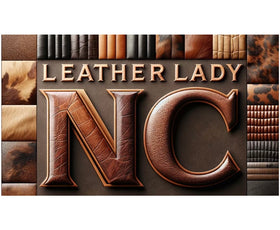
What types of leather are available?
This is one of the top questions we receive so I decided to create a blog post on the various kinds of leather and how to identify them. This post does not cover all types of leather. We'll be cover others in the future but this will give you a basic understanding of the types of leather available and what you will receive if you purchase leather remnants from us.
For the most part we are in the "second tier" of buying leather. We do order some hides direct from the manufacturer but most of the leather and all of the remnants that we purchase are leftover from making furniture which means we get all of the types of leather below as long as the leather meets our quality requirements.
Some remnants come from the highest end of the furniture industry and most of those pieces are full grain or top grain. They comprise 75 to 80% of our purchases. We also purchase from manufacturers who sell more budget friendly furniture and while they may use Full Grain or Top Grain the majority is Genuine leather. Here is an explanation of the different types.
Full-Grain Leather

Full-grain leather is considered the highest quality leather. It's made from the outermost layer of the animal hide and includes all the grain, which gives it exceptional strength and durability. This type of leather retains the natural imperfections and textures of the hide, contributing to its unique character. Over time, full-grain leather develops a patina, enhancing its beauty.
How to Identify: Look for slight imperfections and a natural texture. Full-grain leather feels sturdy and thick.
Top-Grain Leather

Top-grain leather is the second-highest quality. It’s similar to full-grain leather but has had the very top layer sanded off to remove imperfections, making it thinner and more pliable. This process also gives top-grain leather a more uniform appearance. Top-grain leather is often used for high-end products where a balance between durability and suppleness is desired.
How to Identify: It has a smoother, more uniform surface than full-grain leather and feels soft to the touch.
Genuine Leather

Genuine leather, despite its name, is considered lower quality. It's made from the leftover parts of the hide after the higher-quality top layers have been removed. These pieces are often bonded together and then stamped to emulate the texture of higher-quality leather. Genuine leather is less durable and can wear out more quickly.
How to Identify: This type of leather has a more artificial pattern and can feel more rigid or plastic-like compared to higher-quality leathers. You can get an idea of the variances from the image above.
Bonded Leather

Bonded leather is the lowest quality of real leather. It's made from scraps of leather that are bonded together with adhesive and then pressed into sheets. These sheets are then coated with a polyurethane layer imprinted with a leather-like texture. Bonded leather contains only a small percentage of real leather.
How to Identify: It often has a consistent texture that lacks the natural variation of genuine leather. The surface can peel or flake over time, revealing the fabric beneath.
Exotic Leathers
Exotic leathers are made from non-traditional animals, such as snakes, alligators, ostriches, and more. These leathers are prized for their unique textures, patterns, and durability. They are often used in luxury goods and can be quite expensive. We receive and sell embossed leather, which is made to look like some of the exotic leathers.
How to Identify: Look for distinctive patterns unique to the animal's skin, such as the scales of a snake or the quill bumps of an ostrich.
Caring for Different Types of Leather
Understanding how to properly care for different types of leather is crucial to maintaining their beauty and longevity. Regular cleaning and conditioning can keep leather soft and prevent drying or cracking and is the most important thing you can do to keep leather looking great for years. Also leather does not like the sun. While you can apply a leather conditioner to it on a regular basis that will help, keeping leather from prolonged exposure to the sun is generally a good idea.
Conclusion
Recognizing the different types of leather and their characteristics can greatly influence your purchasing decisions and care practices. Whether you're investing in a timeless piece of furniture or selecting a durable leather jacket, knowledge of leather types ensures that you appreciate and maintain the beauty and integrity of the material for years to come.
